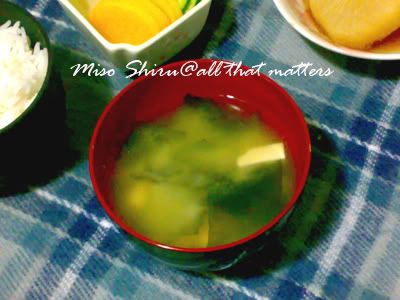
Miso soup or miso shiru (味噌汁) is one fundamental soup served in the Japanese restaurant. I don't know why it is usually served in a laquered bowl, even in a Japanese household. The correct way of drinking the soup is to drink from the bowl directly. Sip the soup, then eat the ingredients with chopsticks. I have seen people 'scooping' the soup and ingredients into their mouth, swallow the soup and then chew on the ingredients that they 'filtered'. That requires skills of some kind but that's not the way to do it.
There are 3 types of miso paste, Shiro Miso or White Miso (しろみそ), Aka Miso or Red Miso (赤みそ) and Kuro Miso or Black Miso (くろみそ). I usually use white miso or red miso for soup. I seldom come across black miso, or maybe I wasn't paying attention at the Supermarket. I have only encountered it at the Aji-tei Sabo restaurant. They used it to pair up with Tonkatsu (豚カツ) or deep-fried pork cutlet as a sauce. It is said that miso paste has health beneficial active ingredients in it, such as enzymes, anti-oxidants and vitamins. However, these will be 'killed' when you boil miso. So the way to go around this is to stir in the miso paste only after you remove the soup stock from the heat.
Miso soup (味噌汁)
Ingredients
600ml of 2nd Dashi Stock
1 tube of Silken Tofu, cubed (it is not a Typo, I used 1 tube, not tub. 250g)
small handful of Wakame Seaweed, cut into bite-size sections
3-1/2 Tbsp of White Miso Paste
Method
1) In a pan, bring the dashi stock to a boil, add in the tofu and wakame and reduce to a simmer.
2) Remove from heat and let the soup stand for a while before stirring in the miso paste.
*Note : I scooped the miso paste into a sieve and submerge it into the soup and stir. This will avoid clumps. You do not have to add salt as miso is already salty on its own.
**Note : I used Wakame that was preserved with sea salt and freezed, not those dried type. If you are using those dried type, you have to gauge the amount used as they will expand to about 3 times their size upon hydration. Also, for those dried type, when they starts to 'open' up, do not boil for too long or they will turn soggy.
***Note : You can use instant dashi granules if preferred. You can add other indredients such as mushrooms, prawns, slices of chicken/pork, scallions or onions, daikon, carrots, baby yams or potatoes. Do note however, do note attempt to add too many things in the soup. It should just consists 2 other ingredients that are of different colours and textures to give the soup some dimension.
The reason I hyphenated these 2 words is because Shio (盐, salt) is a seasoning and Yaki (烧き, grill) is a method of cooking. Remember I said about simplicity in Japanese cooking? What can be simpler than grilling fish and seasoning it with just salt? There is no recipe for this as it is too simple. Ahah. Instead of grilling the fish, I actually pan-fried it and sprinkled abit of salt when it is about done. Saba, also known as mackerel is quite an oily fish. To take away the oily after-taste, serve it with a wedge of lemon and some grated daikon. I did not grate any daikon as I have already dumped in everything I have when I did the Daikon Ni.  I usually pan fry the skin side to a crisp first before I sprinkle the salt and turn the fillet over. Although it contains Omega-3 fatty acid, drain off the excess oil and serve hot with rice.
I usually pan fry the skin side to a crisp first before I sprinkle the salt and turn the fillet over. Although it contains Omega-3 fatty acid, drain off the excess oil and serve hot with rice.
Happy cooking!~ それじゃ~~
Super Easy, Super Moist Chocolate Cupcakes
4 years ago


















No comments:
Post a Comment